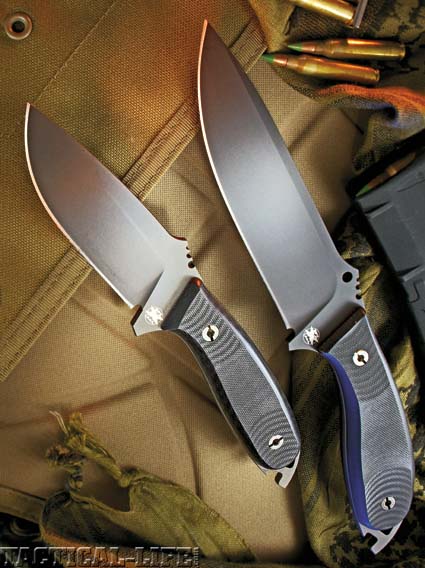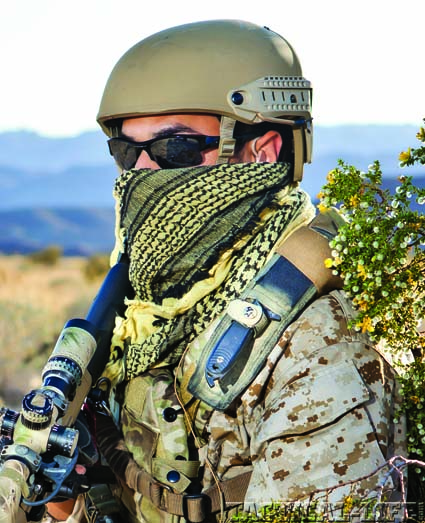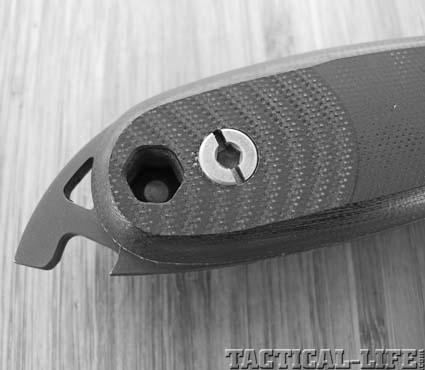
Both the DPx HEFT 4 and 6 were designed for cutting your way out of the world’s most dangerous places! They are so well thought of in the Spec Ops community that many SEALs have been willing to buy these blades out of their own pocket. STEVE WOODS PHOTO
I doubt Robert Young Pelton needs much of an introduction to most Tactical Knives readers. Author of The World’s Most Dangerous Places series of travel guides, Pelton has visited and reported from more combat zones than the U.S. Marines. Whether you are asking about South America’s jungles, Somalia’s savannas, the Middle East’s deserts, or Myanmar’s sweltering tropics, Pelton has been there on its worst day. Naturally, all this first-hand observation of troops under fire has given him a unique perspective on what is and isn’t needed in a combat/survival knife. In recent months, Pelton has utilized that experience to introduce a new line of cutlery under the DPx Gear HEFT (Hostile Environment Fighting or Field Tool) trademark.
Check out this article about The DPx Gear HEST/F 4.0 Ti!
Advertisement — Continue Reading Below
HEFT 4 & 6
Looking at the HEFT 4 and 6 (the numbers refer to the blade lengths). The DPx HEFT 4 features Niolox steel, while the DPx HEFT 6 is Sleipner steel. Blade thickness at the spine runs 5mm. Options include a “Woodsman” model with a stonewash finished blade and Brazilian Santos hardwood handle scales or the “Assault” with a PVD black-coated blade and G-10 handle scales. These handle scales are held on with removable screws that allow access to a storage compartment in the tang. While this hollowed out area is relatively small, it is large enough for fish hooks, firestarters, a button compass or similar survival items. Both knives are made by LionSTEEL in Maniago, Italy.
The sample knives each came in a black ballistic nylon sheath with a wide Velcro flap that completely covered the handle and most of the scabbard when closed. Frankly, this system did not impress me as very practical for a serious combat knife. Not only would it slow down drawing the knife, the Velcro makes entirely too much noise on a dark, quiet night.
Shortly after receiving the knives, DPx also supplied photos they had taken of members of a SEAL team training with the knives on their web gear. The first thing I noticed was that the SEALs were using a different sheath with a more conventional snap loop around the handle of the HEFT knife. When I asked about this I discovered that the Navy Spec Ops troops had also objected to the original Velcro flap version of the sheath and it had been replaced. I was also told that yet a third generation version is in the works and should be available by the time you read this feature. It is nice feeling when the current guys in Spec Ops back me up on these little points…
Advertisement — Continue Reading Below

Author was happy to find that the original Velcro flap ballistic nylon sheath had been replaced with a more accessible handle snap loop version at the request of the SEALs. Author was told this is being further refined and a third generation will be available in the near future. PHOTO COURTESY OF DPX

The smaller knife also offers a magnetized hex-driver cut-out on the end of the handle.
Well-Designed Handle
One of the design features of the HEFT knives, according to DPx, is that the handles are “expertly balanced for hours of hard use without causing blisters, hot spots or bruising.” I know from experience that many handles that work sort-of-okay for a quick cut or two prove less satisfactory when you are forced to use them for long periods of heavy work. My motto is that the best way to evaluate any knife is to cut “things” that actually need cutting even if they aren’t the exact purpose the blade was designed for. Springtime for me means making large quantities of garden stakes from hazel saplings. Each requires that a sharp point be whittled on to one end and turning out several dozen of these constitutes a good test of just how comfortable a knife handle is in the long run. I’ll have to go with DPx on this one, the handle design is very comfortable for long periods of use.
Advertisement — Continue Reading Below
Another interesting discovery was that I found the 4-inch model mechanically more efficient at pointing the stakes as it was easier to apply proper leverage to the shorter blade. Both of these knives have basically the same edge geometry, but if the 6-inch blade had been profiled a little thinner, that equation might change.
Combat Length
At a recent trade show in Las Vegas, Pelton and I had a discussion about the most desirable length for a combat knife on the modern battlefields. He felt most of the current troops are content with a blade around 4 inches, while my own experience argues for something a little longer than that. For starters, anyone that tells you superior training will make a short blade just as effective as a longer one in a hand-to-hand fight has never used a knife to stick anything two or four legged. If you don’t believe me, just ask someone who hunts wild hogs with a knife.
Using a 4-inch blade is the same as putting your faith in a small caliber handgun over a high performance .40 or .45. I’m sure some will make the case there is little chance of anyone needing a knife as a weapon in combat. If that is your situation then the 4-inch HEFT is probably the proper way to go. As for me, I would still rather have the extra 2 inches of penetration the 6-inch model offers if I were out on the pointy end of the stick again.
Advertisement — Continue Reading Below
So having just put down the 4-inch HEFT for infantry use, I will say it is an excellent cutting tool for the vast majority of civilian outdoor needs, including field dressing big game. Given I live in the real world, that probably means I will be carrying the smaller model much more often in the woods than the 6-inch model.

When it gets down to the real world, combat knives are used as tools far more often than they are for weapons. PHOTO COURTESY OF DPX
Blade Steel
Saying the blade steel is something close to D2 probably set off a few readers’ alarms, as that alloy has a reputation for being hard to resharpen. Most of the D2 knives I’ve used have not been a real problem, but I can remember at least one from a famous custom maker that gave me so many fits I eventually traded it off. At the time, that particular maker was famous for his relatively low Rockwell D2 blades. He has since changed to other steels alloys for all of his knives, so maybe he has seen the light, too. As for the DPx knives, I had no problem restoring either blade to a sharper than out-of-the-box edge using the medium and fine India stones on a Norton Cradle sprayed with WD-40 for lubricant. Field touch ups were also easily accomplished with a diamond surfaced sharpening rod.
Advertisement — Continue Reading Below
I would be totally deficient if I didn’t mention one other feature of the HEFT knives, a notch opener built into the tang of the knife on the end of the handle. While this will obviously work for prying off the lids of various other types of food containers, most troops are going to see it as a “beer bottle opener.” It never hurts to remember that in most third world countries, all beer and soft drinks still come in pry-off crown cap containers. Another feature that seems to only be found on the 4-inch model is a “hex driver” set into the rear of the handle scales on the right hand side.
I’m told that many SEALs have liked this knife well enough that they have happily bought their own out of pocket. As we all know, Naval Spec Ops teams tend to have the option of obtaining whatever gear they feel they need to best get the job done. It proves a lot about these knives that they would pick a HEFT over the many other options available to them.






















